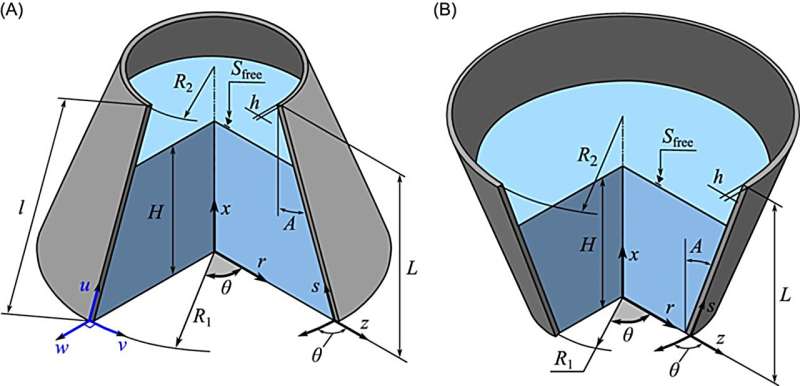This article has been reviewed according to Science X's editorial process and policies. Editors have highlighted the following attributes while ensuring the content's credibility:
fact-checked
proofread
Tuning into the frequencies of conical shells: Research reveals a fluid-structure symphony

Truncated conical shells are essential in industries such as aerospace and marine engineering, where understanding their dynamic behavior is crucial. Traditional research has primarily focused on cylindrical shells, leaving a gap in the literature regarding conical structures.
These shells experience complex interactions with internal fluids, affecting their stability and performance. Based on these challenges, it is imperative to conduct an in-depth study on the vibrational characteristics of fluid-filled conical shells to improve their design and application in various engineering fields.
Scientists at the Laboratory of Functional Materials, Institute of Continuous Media Mechanics, have made significant strides in understanding fluid-structure dynamics.
Their research, published in the International Journal of Mechanical System Dynamics, explores the vibrational behavior of conical shells, providing a foundation for advancements in engineering design and safety.
This study employs classical shell theory and acoustic approximations to analyze the vibrational behavior of truncated conical shells partially filled with an ideal compressible fluid. The dynamic behavior of these structures is modeled through a system of ordinary differential equations, solved using the generalized differential quadrature method and Godunov's orthogonal sweep method.
The research identifies how fluid levels and cone angles influence the natural frequencies of the shells under different boundary conditions, including simply supported, rigidly clamped, and cantilevered configurations.
Numerical analyses demonstrate that certain configurations can achieve higher natural frequencies than equivalent cylindrical shells. The study also verifies its results against known numerical and analytical solutions, establishing accuracy and reliability. These findings provide valuable insights for optimizing the design and application of fluid-filled conical shells in various engineering fields.
Dr. Sergey A. Bochkarev, one of the lead researchers, said, "Our findings highlight the intricate relationship between fluid levels, cone angles, and the vibrational properties of conical shells. This research not only fills a significant gap in the literature but also offers practical guidelines for the design of fluid-filled conical structures in engineering."
The implications of this research are vast, particularly for industries relying on the structural integrity of fluid-filled conical shells. The insights gained can lead to improved design and optimization, enhancing performance and safety in applications ranging from aerospace to civil engineering.
Future studies may further refine these models, incorporating real-world complexities such as fluid-structure interactions and non-linear dynamics, to extend the applicability of these findings.
More information: Sergey A. Bochkarev et al, Analysis of natural vibration of truncated conical shells partially filled with fluid, International Journal of Mechanical System Dynamics (2024). DOI: 10.1002/msd2.12105
Provided by TranSpread





















